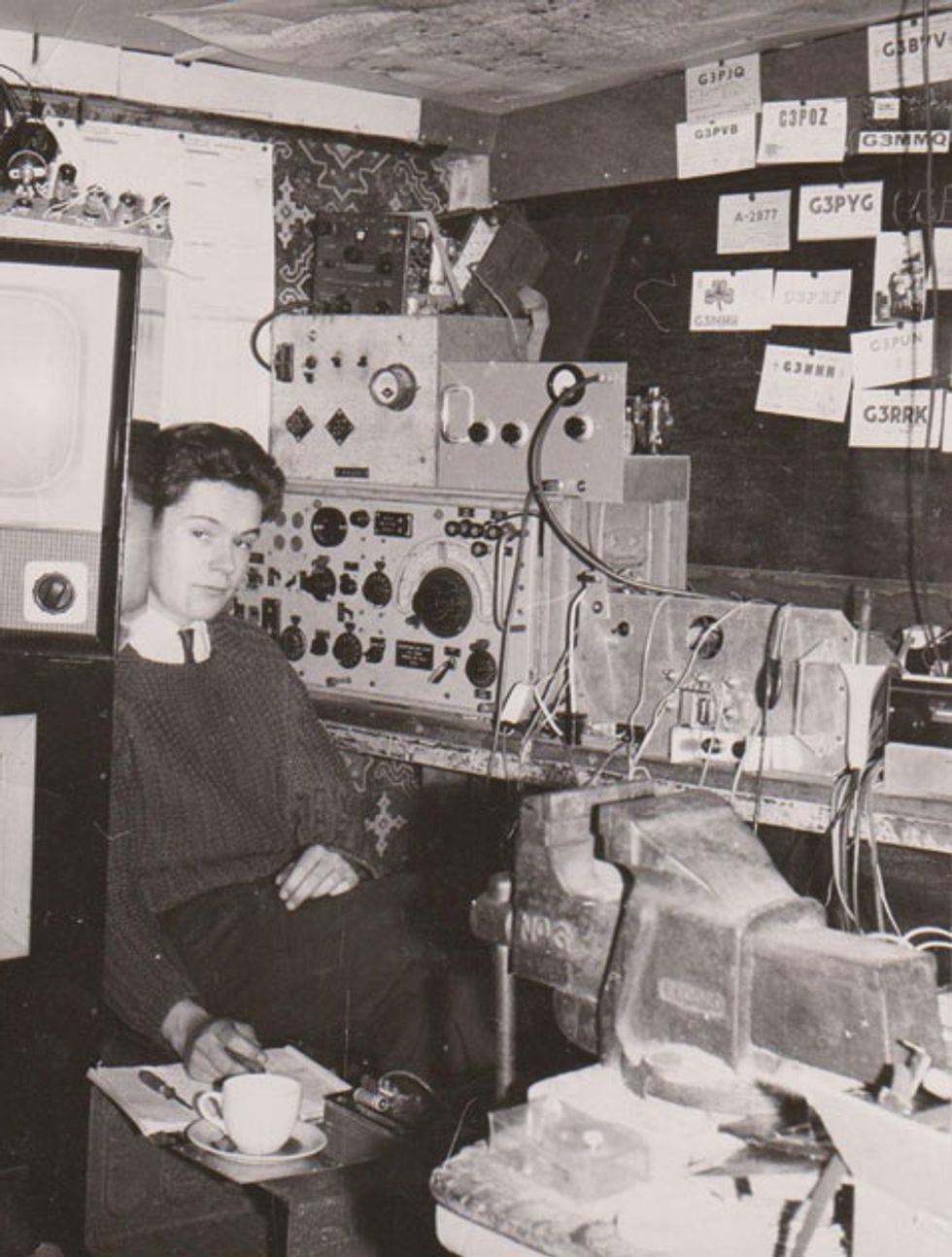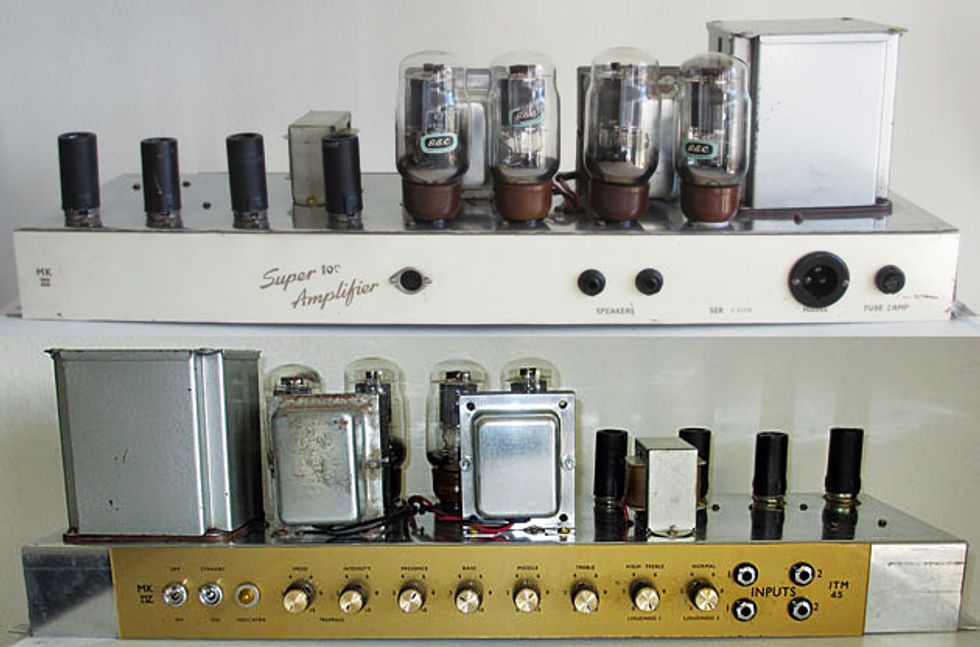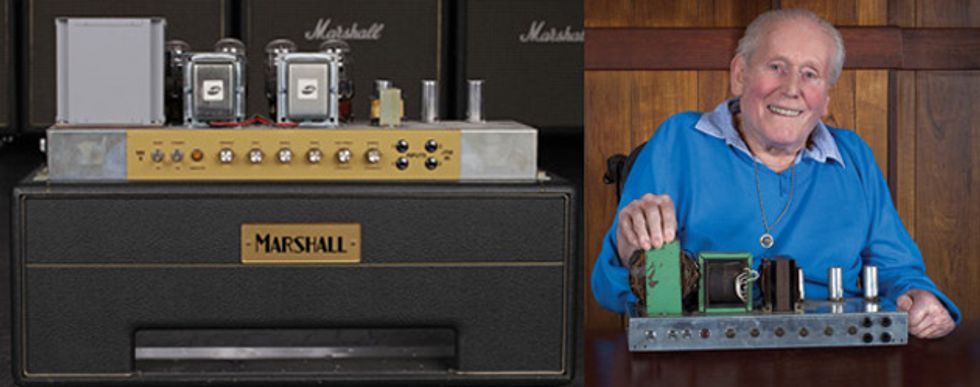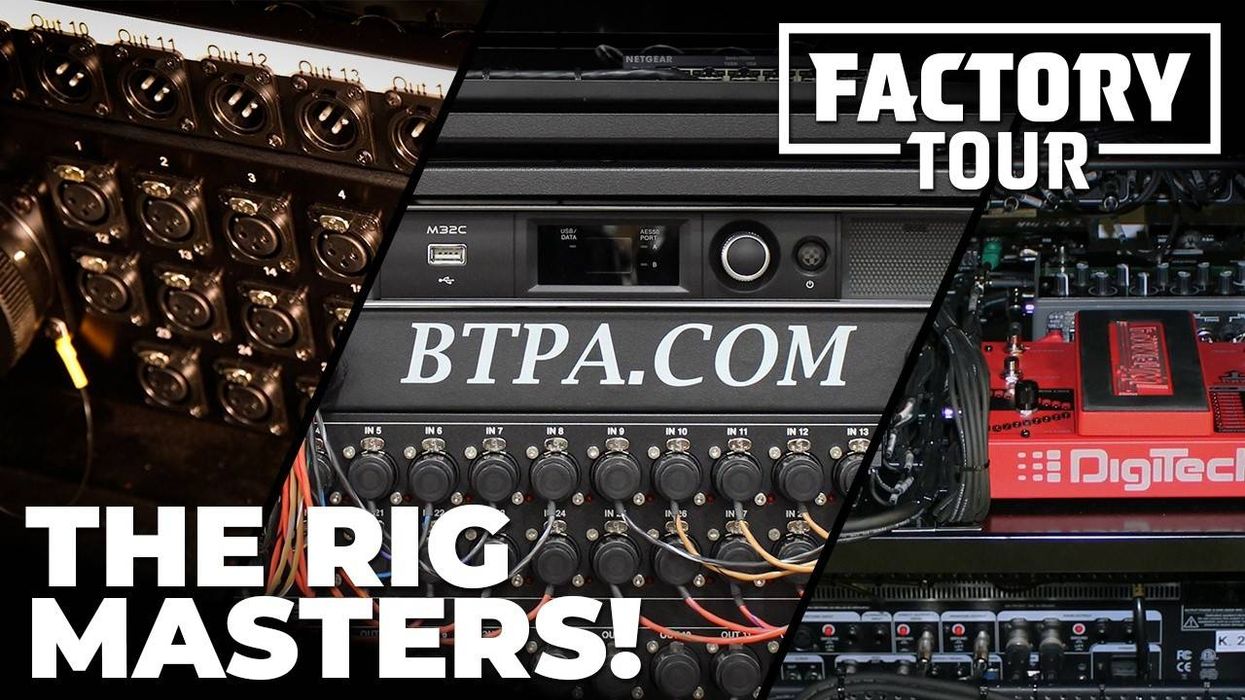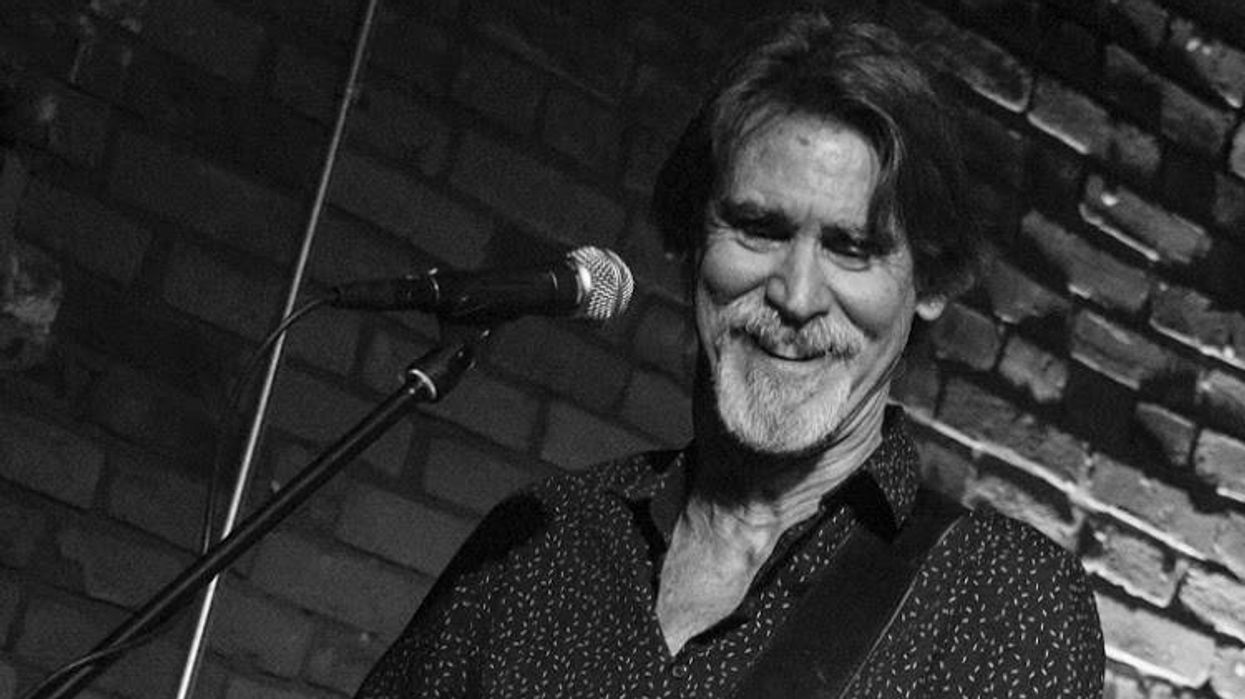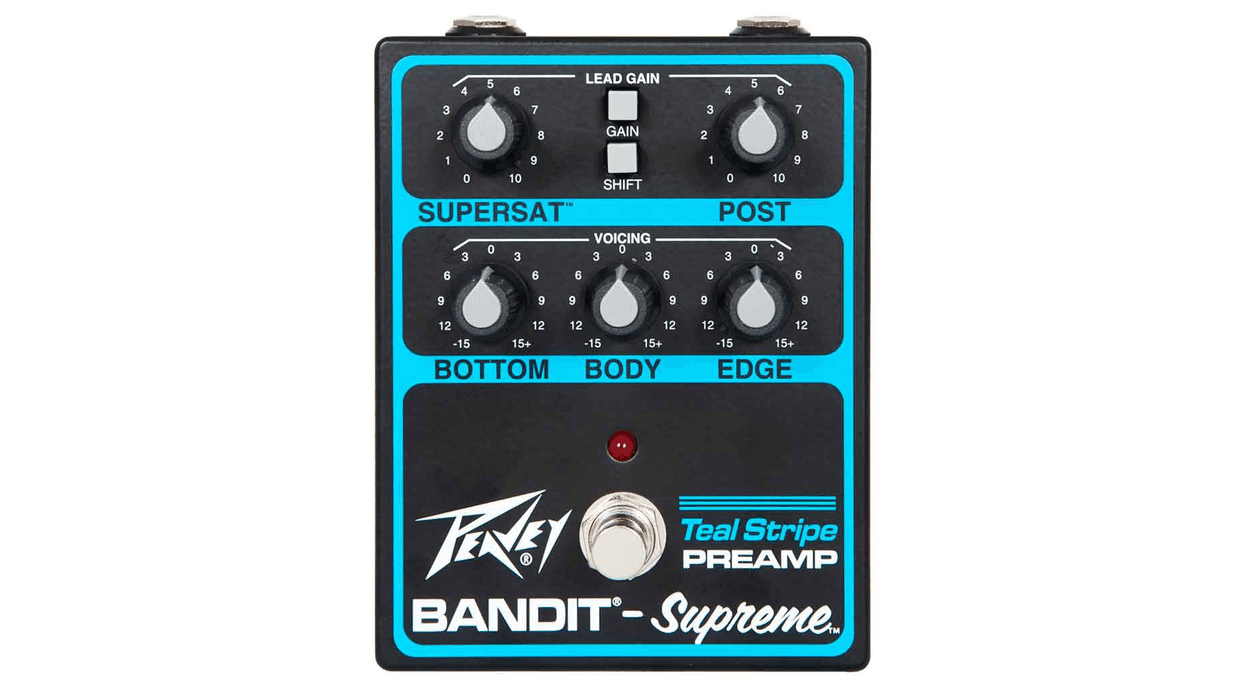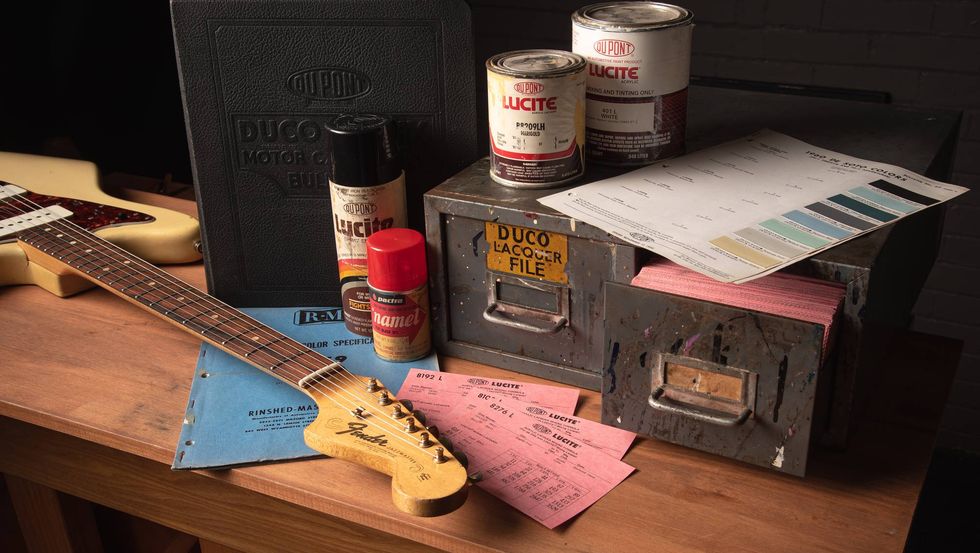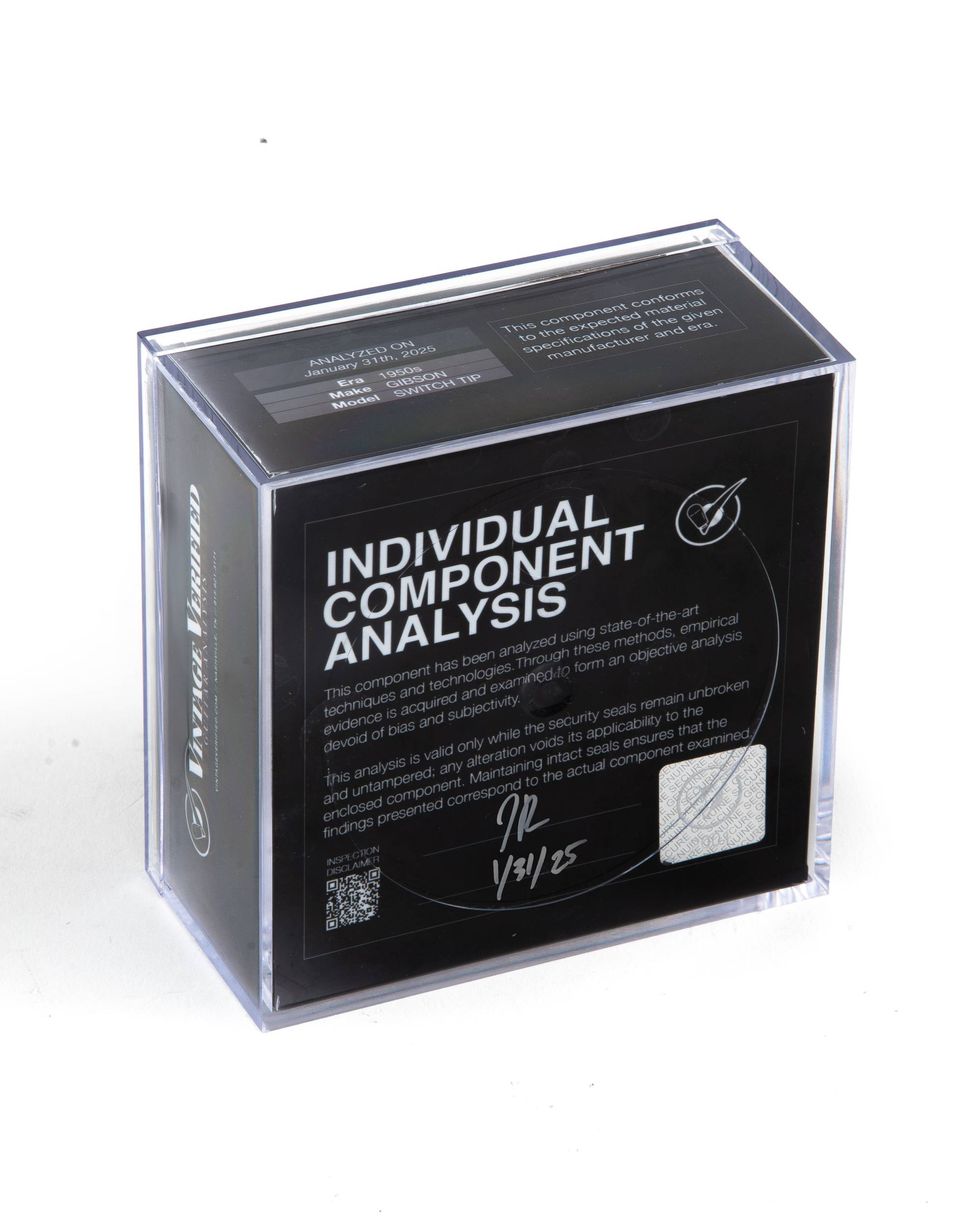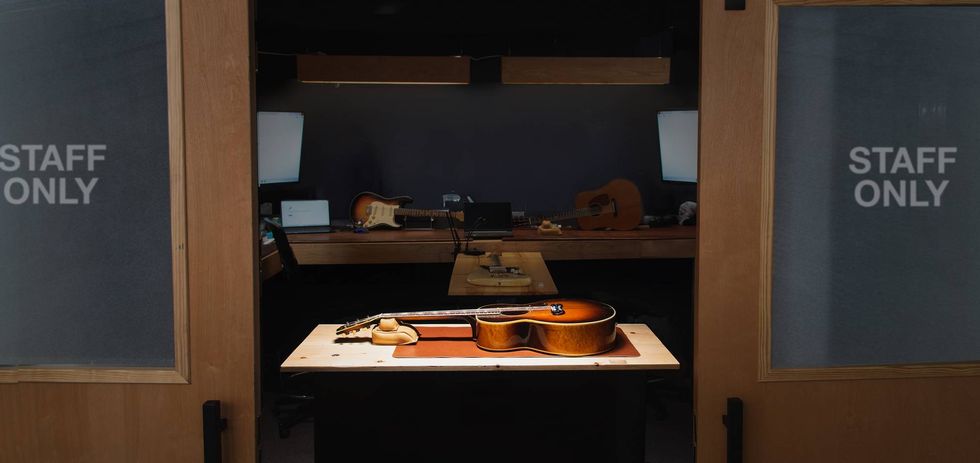It’s the stuff of rock legend: In the summer of 1965, Pete Townshend asked Jim Marshall to build an amp even larger and louder than Marshall’s current JTM45 model. Marshall delivered with model 1959, sometimes called the JTM45/100 due to the fact that early models featured the JTM45’s distinctive front-panel. It featured four output tubes in place of the JTM45’s two tubes. The Who first used the new model—with a colossal 8x12 cabinet—sometime around November 12, 1965. Finally, the band had amplifiers loud enough to compete with Keith Moon’s explosive drumming.
But there’s more to the story of the first 100-watt stack. Jim Marshall (who passed away in April 2012 at the age of 88) and his visionary colleagues, Ken Bran and Dudley Craven, had to surmount countless design hurdles and battle the technical limitations of available components. It’s a tale of ingenuity, dogged determination, and sheer lust for power.
But to tell it, we must back up a few years.
The Genesis of Crunch
It was probably just a matter of time before someone realized that rock ’n’ roll needed another voice for its guitars in addition to clean Fender amplifier tone. But who would have thought that someone would be a drummer? A drum teacher, Marshall began selling drums on July 7, 1960, at his new shop at 76 Uxbridge Road in Hanwell, a town in the London borough of Ealing. “All the drummers used to bring their groups in with them, which is how I got to meet guitarists like Pete Townshend and Ritchie Blackmore,” Jim later said. “They kept pestering me to stock guitars and amps, so I decided to give it a go.” As a result, Jim expanded to electric guitars, basses, and amplifiers—a wise move due to the booming rock ’n’ roll market.
In 1962, Jim hired Ken Bran as his repair engineer. Marshall’s shop was selling Fender and Selmer amplifiers, but Fenders were expensive in the UK, and Selmers broke down too often. In conversations with players who came to his shop, Jim realized many were searching for a sound they couldn’t quite get from amps available at the time. “Listening to what they were saying gave me a very good idea of what they wanted,” Jim recalled. “So, I decided to put together a small team to build a valve amplified with the specific sound the lads were after.” As a result, Marshall and Bran discussed producing their own amplifier. Bran told Marshall that he was comfortable doing repairs, but could not create a complete circuit. He recommended Dudley Craven, an electronics apprentice then working at EMI Electronics. Craven, 18, was known as the “Whiz Kid” because of his youth and skill with electronics. He jumped at the challenge of realizing Marshall’s vision of a rock ’n’ roll guitar amp. Ken Flegg also joined the team as an engineer who assembled the components on tag boards.
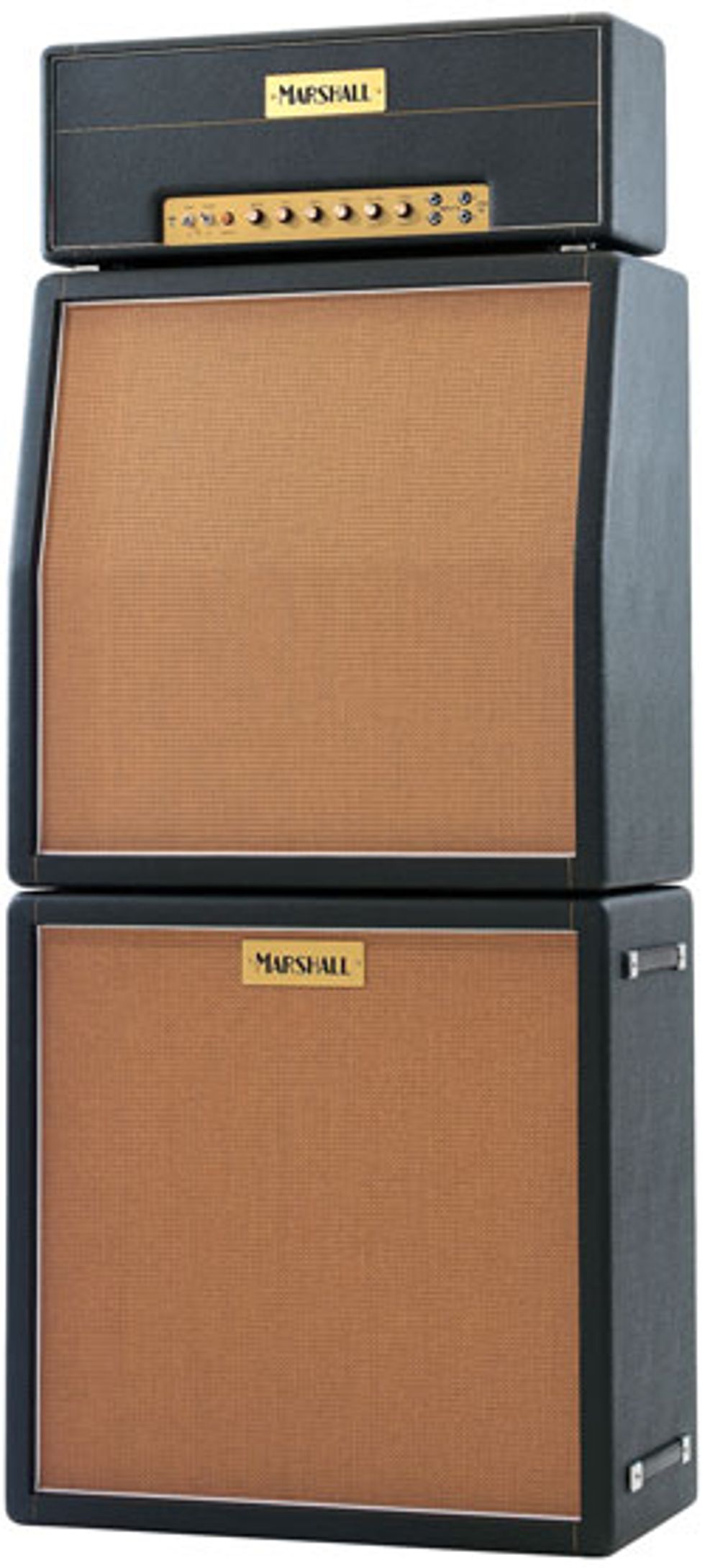
Marshall's 40th Anniversary JTM45/100 head and 4x12 cab reissues. Photos courtesy of Marshall Amplification.
Creating the First Marshall Amplifier
In the fall of 1962 Craven was living at 202C Uxbridge Road while working for Marshall. Behind the house was the tiny ham radio shack where Craven broadcast as “G3PUN.” Here Craven conducted most of the original testing of the JTM45, Marshall’s first amplifier. Friends would sometimes find Craven asleep at the workbench, exhausted from trying to keep up with amplifier orders.
JTM45 prototyping began in September 1962. In those early days Marshall would fabricate the aluminum chassis, preparing it for component mounting. Bran would obtain and install the bolt-on components, at which point Craven, the chief designing engineer, would take over the build, installing the circuit board, wiring everything, installing tubes, and setting the bias. The team produced about one amplifier per week. When a prototype was completed, Marshall would ask Pete Townshend or Ritchie Blackmore to demo the amplifier at his shop. After five prototypes, a sixth was chosen to become the production model. “As soon as I heard it I said, ‘that’s it – that’s the Marshall sound.’” Jim later remembered. “It was the sound I could hear in my head based on what the boys told me they were looking for.” This unit would become known as the “#1 amp.” Its circuitry essentially mimicked that of the 5F6-A Fender Bassman amp, though with some subtle departures that resulted in different gain, loading, brightness, and harmonic content.
By June 1964 the first Marshall factory had opened on Silverdale Road in Hayes. The 5,000 square foot facility was staffed by 15 employees who produced about 20 amps a week. Celebrities like Brian Poole & the Tremeloes and the Who would drop by, creating an exciting work environment.
Enter the Who
In 1965 Pete Townshend and John Entwistle of the Who were trying any amp that might be heard over Keith Moon’s drums. They briefly used Vox amplifiers, though they were ultimately deemed unsatisfactory.
At the time most amplifier components were rated up to 450 volts of direct current (VDC) and would fail at higher voltages. Said Townshend in an August 1996 interview with (now-defunct) British magazine Guitar, “Fender didn’t go any further with it after the late ’50s. The theory was if you went any further, literally all the other components would melt because they’d been designed for much lower voltages.” Marshall built a 50-watt amplifier known as model 1987 for Townshend, but it wasn’t loud enough. “I went back and said, ‘No, I want it even louder, even bigger,’” he told Guitar.
Seventeen-year-old Dudley Craven in his tiny ham radio shack, circa 1961. Many of the Marshall JTM45 prototypes would be refined and tested here. Photo courtesy of Barbara Craven.
But the amp’s unique harmonic characteristics caught the guitarist’s ear. “I got very angry, very frustrated,” he remembers. “I kept pushing them. I said, ‘You’d better [expletive] do this—there’s something happening here which is really interesting. You get up to a certain pitch, and something happens between the pickup and the amp. The guitar kind of starts to sound like a symphony orchestra.”
It was almost as if Townshend could peer into the future and see that overdrive would shape the new sound of rock ’n’ roll. “I knew that in distortion there was a music of a much higher harmonic order than anything that I could play,” he said in the aforementioned interview. “So I started that whole trip off.”
Bigger and Louder: Model 1959
In mid 1965 Marshall asked Craven and Bran to begin prototyping what would become model 1959, also known as the JTM45/100—Marshall’s first attempt at a louder amp. The design team increased the power by building up the JTM45 circuit, while taking pains to prevent the components from overheating. All amplifier manufacturers knew heat was the enemy of a reliable amplifier.
The first model 1959 prototype was totally experimental. It used one 5AR4/GZ34 rectifier tube, four 6V6 output tubes, and three ECC83/12AX7 preamp tubes for about 60 watts of power. They used a Radiospares “De Luxe” output transformer, but it couldn’t handle the power. The windings melted.
The second prototype was quite different. This amplifier used two 5AR4/GZ34 rectifier tubes, four 5881/6L6 output tubes, and three ECC83/12AX7 preamp tubes. The amp used two Radiospares 30-watt output transformers, which together could handle the amplifier’s power. This prototype reassured the design team they were going in the right direction.
Third Time’s the Charm
Craven perfected model 1959 with a third prototype in the fall of 1965. The design team had replaced the 5881/6L6 output tubes with KT66 tubes, which were easier to source in England. After testing with the dual 30-watt output stage, it became clear that heavier-duty output transformers were required. Craven selected a pair of Drake 50-watt output transformers (784-74), because at the time no 100-watt output transformers were available.
This third prototype of the Marshall model 1959, serial #6406, may be the first 100-watt Super Tremolo amplifier. These early 100-watt amplifiers incorporated a unique dual-output transformer design. There is no impedance selector switch.
Texas Instruments TS107 silicon diodes replaced the inefficient tube rectifiers, increasing power and changing the amplifier’s sonic character. The mushy “sag” characteristic of tube rectifiers was gone. The bottom end was tighter. Highs were clearer. The response was faster. And there was an added benefit: The amplifier would never fail due to a bad rectifier tube.
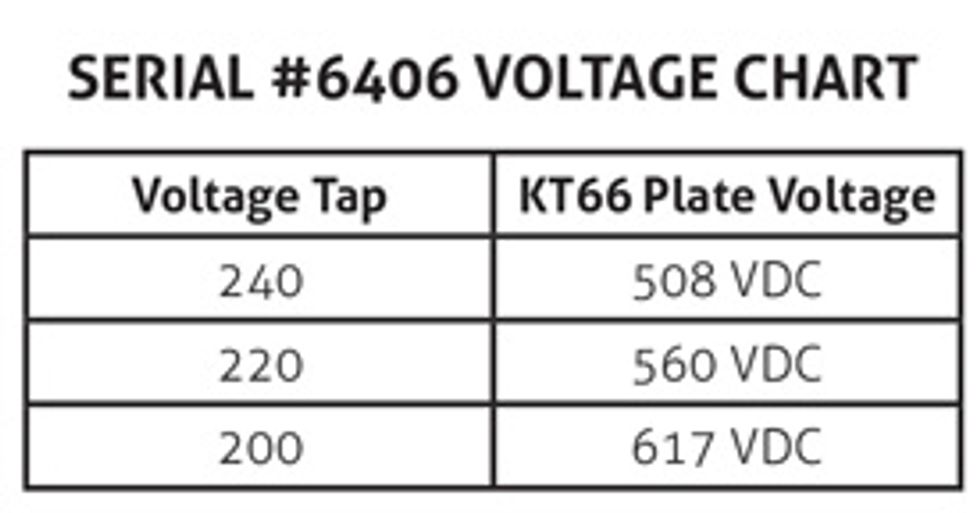
The power transformer was a large military/industrial-grade model manufactured by Radiospares. Because this amplifier was used only for prototyping, the power transformer did not have a USA voltage tap.
The chart (right) shows the various voltages that can be obtained from the three taps on the power transformer in amplifier #6406—which is owned by the author and is one of the 12 original, dual-output 100-watt Marshalls.
Dual-Output 100-Watt Marshall Amplifiers
Dual-output Marshall amplifiers were manufactured for a few months in late 1965 and are extremely rare. Decades later, when Marshall conducted research for the 40th anniversary of the 100-watt stack, it was determined that a total of 12 dual-output amplifiers were manufactured, including the third prototype of model 1959. Ten of these 12 amplifiers were built with Radiospares power transformers with the USA voltage tap.
The dual-output model 1959 was available as a PA, bass, or lead model. These early amplifiers were built on aluminum chassis that are prone to warping and cracking under the weight of the transformers. The front panel is gold plexi, a look borrowed from the JTM45. (That’s why some refer to the early model 1959s as JTM45/100s.) The PA amps received JTM100 gold plexi panels. The back panels were white with the “Super Amplifier” logo silkscreened in gold. The first few amplifiers used square power boards, which would have trouble clearing several of the output tube sockets and the internal fuse. Eventually the power board was cut slightly to provide clearance for these components.
Look closely at this internal view of #6406 and you’ll see that the 1959T has an extra ECC83/12AX7 tube for the tremolo circuit. To the left is the tremolo circuit board, with the main circuit board in the center and the power board at the right. This early version uses a bridge rectifier with the robust Radiospares military/industrial power transformer. When most recently acquired, this amplifier was missing some original parts, but was restored using the most accurate possible replacements. Photo by Michael Brown.
In November 1965 the Marshall team completed several of the new 100-watt amplifiers ordered by the Who. The band dispatched their roadie to retrieve their new gear. He proceeded to throw each amplifier into his truck one after the other, just like firewood. “I can’t believe he just did that!” Jim Marshall would later recall thinking.
Townshend’s 8x12 and the Birth of the Stack
At the same time that Townshend demanded Marshall build him 100-watt “weapons,”, he also asked for 8x12 speaker cabinets. Jim later shared what Townshend said when he warned him that they’d be nearly impossible to move. “I told Pete, ‘no problem, I’ll make a 4x12 with a straight front and then put an angled one on top.’ He shook his head and said, ‘No, I don’t want that, Jim, I want all eight speakers in one cabinet.’ I told him that it was going to be too heavy and that his roadies were going to complain like mad. His reply was, ‘Never mind them, they get paid,’ and off he went!” Townshend ordered four of the behemoths fitted with Celestion T652 12" speakers, which are similar to 15-watt Celestion Blue Alnico 12" speakers. The bottom half of the cabinet was closed, while the top half was partially opened.
YouTube It
In this clip of the Who performing at London’s Fifth National Jazz & Blues Festival on August 6, 1965, you can tell that the bass and guitar sounds aren’t great, which could explain why Pete Townshend and John Entwistle don’t look very happy. At the 2:05 mark, a frustrated Townshend fiddles with switches on his Vox amps before taking off his Rickenbacker guitar and launching it over them. This was around the time he ordered 100-watt Marshalls for the Who.
At this gig in France, Townshend and Entwistle each use one 100-watt stack. Townshend’s Fender Telecaster allows you to really hear the Marshall head’s dynamics and how its GEC KT66 output tubes work in concert with the T652 alnico speakers in the 8x12 cabinet. The tremolo model’s two additional knobs and longer control panel distinguish it from the bass model.
At the historic Pier Pavilion (it’s misidentified as “Pear Pavilion” in the video’s opening screen) in Suffolk county, UK, Pete Townshend and the Who blaze through “I’m a Boy,” “Substitute,” and “My Generation” before trashing the stage. Notice the battle-scarred 8x12 cabinets. Townshend and Entwistle each play through two full stacks, and the tone is wonderful.
Marshall presumably tested the first 8x12 cabinet using one or more of the 12 original, dual-output amplifiers. Though Marshall can’t corroborate which exact amp was used, an old masking-tape diagram on the back panel of #6406 shows where the output jacks were located and how each half of the 8x12 cabinet was 16 ohms, for a total load of 8 ohms.
The 8x12 idea didn’t last long for Townshend, though. As Marshall recounted, “A couple of weeks later, he came back and said, ‘you were absolutely right, Jim, they are way too heavy, my roadies are furious!’ He wanted me to just cut the 8x12s in half but that wasn’t possible because of the way they were made—we weren’t using fingerlocked joints in those early days, so the cabs were butt-jointed. So I told him, ‘Look, Pete, I can’t do that because the whole thing will fall apart if I do! Just leave it with me and I’ll get it sorted out.’ So I ended up doing what I wanted to do in the first place—a straight-fronted cab with an angled one sitting on top.” Jim concluded, “the stack was a combination of design ideas from Pete and myself. I don’t mind admitting that we initially built the stack with looks very much in mind, because a wall of them does make a fantastic backdrop on any stage.”
A 2005 40th Anniversary JTM45/100 (left) head cabinet and chassis, complete with dual Drake transformers. The late Jim Marshall (right) with the first JTM45 head in 2011. Photos by Matt York.
40 Years Later
In 2005 Marshall celebrated the 40th anniversary of the 100-watt stack with a limited run of 250 full-stack replicas of the original amplifier and speaker cabinets. Finally, more guitarists could gain access to the dynamic tones of a dual 50-watt output stage. The 40th anniversary cabinets recreate the 8x12 look and sound via two 4x12 cabinets loaded with Celestion T652 alnico speakers.



